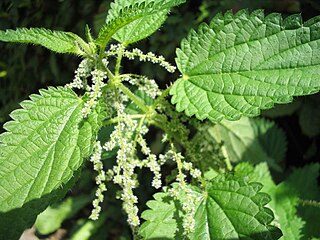
The Urticaceae are a family, the nettle family, of flowering plants. The family name comes from the genus Urtica. The Urticaceae include a number of well-known and useful plants, including nettles in the genus Urtica, ramie, māmaki, and ajlai.

Pilea, with 600–715 species, is the largest genus of flowering plants in the nettle family Urticaceae, and one of the larger genera in the Urticales.
Critoniopsis tungurahuae is a species of flowering plant in the family Asteraceae. It is found only in Ecuador. Its natural habitats are subtropical or tropical moist lowland forests and subtropical or tropical moist montane forests. It is threatened by habitat loss.
Pilea cataractae is a species of plant in the family Urticaceae. It is endemic to Mauritius. Its natural habitat is subtropical or tropical dry forests.
Pilea jamesonia is a species of plant in the family Urticaceae. It is endemic to Ecuador. Its natural habitat is subtropical or tropical moist montane forests.
Pilea laevicaulis is a species of plant in the family Urticaceae. It is endemic to Mauritius. Its natural habitat is subtropical or tropical dry forests.
Pilea myriophylla is a species of plant in the family Urticaceae. It is endemic to Ecuador. Its natural habitats are subtropical or tropical dry shrubland and subtropical or tropical high-altitude grassland.
Pilea napoana is a species of plant in the family Urticaceae. It is endemic to Ecuador. Its natural habitat is subtropical or tropical moist montane forests.
Pilea pollicaris is a species of plant in the family Urticaceae. It is endemic to Mauritius. Its natural habitat is subtropical or tropical dry forests.
Pilea riopalenquensis is a species of plant in the family Urticaceae. It is endemic to Ecuador. Its natural habitats are subtropical or tropical moist lowland forests and subtropical or tropical moist montane forests.
Pilea schimpfii is a species of plant in the family Urticaceae. It is endemic to the Chimborazo, Napo, El Oro, and Carchi provences of Ecuador. Its natural habitats are subtropical or tropical moist lowland forests and subtropical or tropical moist montane forests. During the second world war, the only plants in captivity were destroyed in the German herbarium in Berlin, Germany.
Pilea selbyanorum is a species of plant in the family Urticaceae. It is endemic to Ecuador. Its natural habitat is subtropical or tropical moist lowland forests.
Pilea serratifolia is a species of plant in the family Urticaceae. It is endemic to Ecuador. Its natural habitats are subtropical or tropical moist montane forests and subtropical or tropical high-altitude shrubland.
Pilea topensis is a species of plant in the family Urticaceae. It is endemic to Ecuador. Its natural habitat is subtropical or tropical moist montane forests.
Pilea trichosanthes is a species of plant in the family Urticaceae. It is endemic to Ecuador. The natural habitats of Philea trichosanthes are subtropical or tropical moist lowland forests and subtropical or tropical moist montane forests.

Pilea microphylla also known as rockweed, artillery plant, gunpowder plant or brilhantina is an annual plant native to Florida, Mexico, the West Indies, and tropical Central and Southern America. In the southern part of México, specifically Campeche and Mérida, the local name is Frescura. The plant belongs to the family Urticaceae. It has light green, almost succulent, stems and tiny 1/8" leaves which contribute to its other nickname, "Artillery Fern", though it is not related to ferns. It is grown as a ground cover in many areas.

Pilea peperomioides, the Chinese money plant or missionary plant, is a species of flowering plant in the nettle family Urticaceae, native to Yunnan and Sichuan provinces in southern China.

UCT Radio is a campus radio station operated by students of the University of Cape Town (UCT) in Cape Town, South Africa. UCT Radio broadcasts on the 104.5 MHz frequency from a 20 watt transmitter located at 33°57′30″S18°27′45″E. According to the University website, the station broadcasts its signal from the main Upper Campus in the Southern Suburbs, and all the way across the Cape Flats towards the Northern Suburbs of the greater Cape Town area.

Pilea trianthemoides, the artillery plant, is a species of shrubs or subshrubs in the family Urticaceae, native to Florida and the Caribbean islands, where it grows in waste places and moist thickets. It flowers year round.






